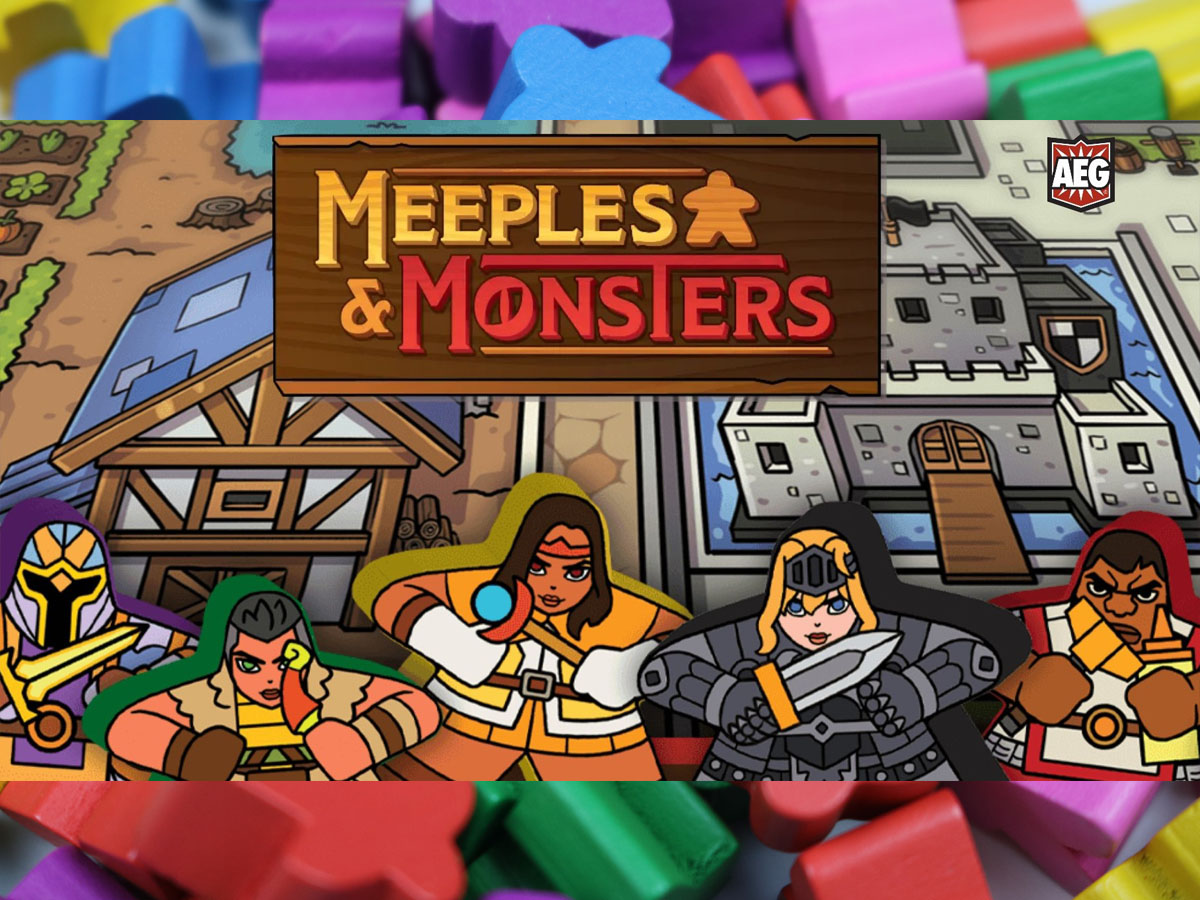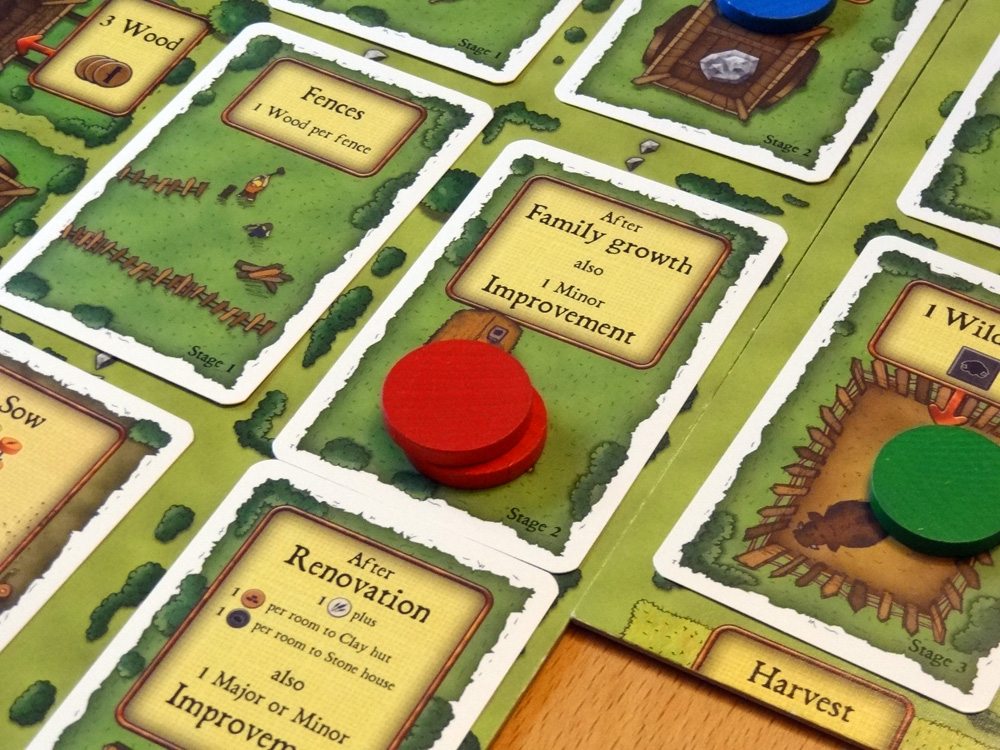The city of Rowan is under siege from the forces of Moredraw! The evil Saw Ron has summoned monstrosities from the realm of Peepul, and a dark shadow has fallen across the land. Now, the King has turned to you to save Rowan from the dark powers. Will you defeat them and be declared the new Earl Marshall?
What Is Meeples & Monsters?
Meeples & Monsters is a bag building and worker placement game for 1-4 players, ages 13 and up, and takes about 45-60 minutes to play. There are a lot of different strategic choices to make, so it will probably work best with teens and adults. It’s currently seeking funding on Kickstarter, with a pledge level of $49 for a copy of the game.
Meeples & Monsters was designed by Ole Steiness (Champions of Midgard) and published by Alderac Entertainment Group (AEG), with illustrations by Gong Studios.
New to Kickstarter? Check out our crowdfunding primer.
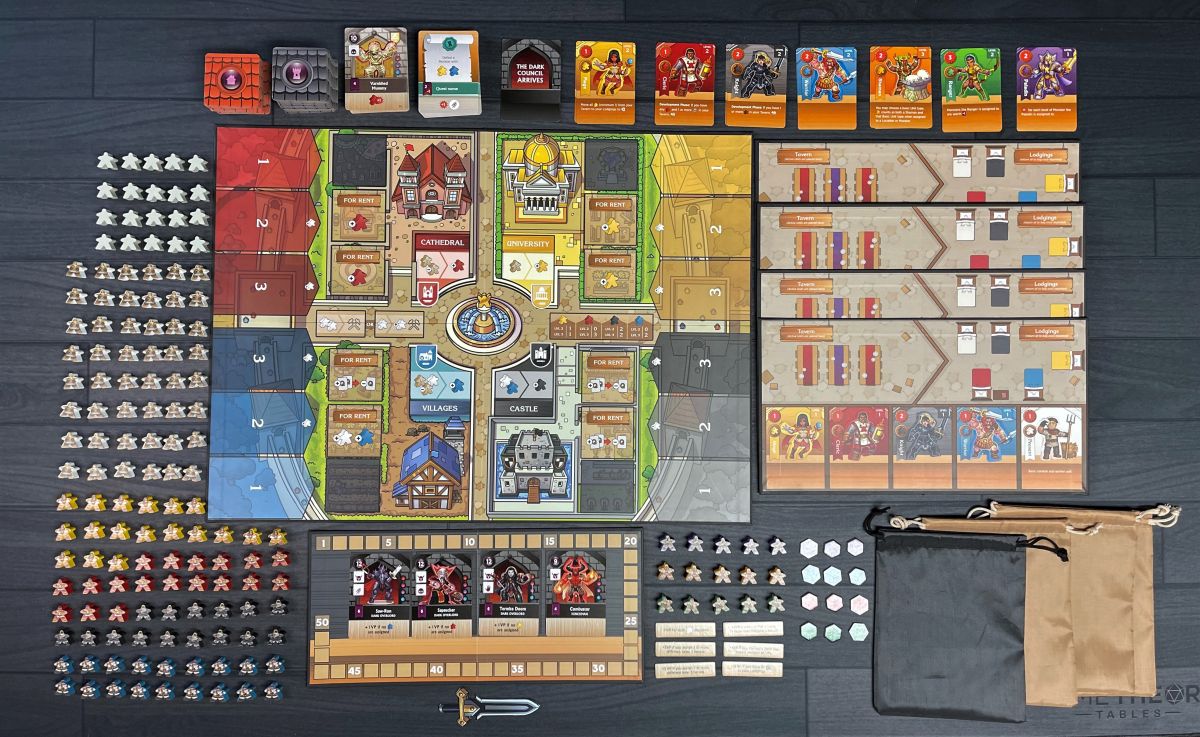
Meeples & Monsters Components
Note: My review is based on a prototype copy, so it is subject to change and may not reflect final component quality. The bags will definitely be changed, as the Kickstarter campaign features embroidered bags as a free upgrade.
Here’s what comes inside the box:
- 44 Monster Cards
- 3 Dark Council Arrives Cards
- 28 Hero Cards
- 44 Quest Cards
- 15 Building Tiles
- 152 16mm Meeples
- 4 Player Boards
- 12 Player Tokens
- 1 1st Player Sword Token
- 4 Player Bags
- Game Board
- Final Encounter Board
- 4 Dark Council Cards
- 6 Dark Council Power Tokens
- Rulebook
- 4 Towers Expansion
- Solo Game

The game board is divided up into four different regions. Each region offers different rewards for placing your meeples, and each has 3 spaces for monsters to attack. There are also a couple of “region-neutral” locations, where you can take a build action or upgrade your heroes.
Players will each have an identical player board. These have areas to place both the meeples you’ll draw from your bag, as well as the ones that are exhausted during the player’s turn. At the bottom of the boards are illustrations of the first level of all the basic units. In the game you’ll be able to upgrade all of those but the peasant, who will always remain at the 1st level.

The last board in the game is the Final Encounter board. There, you’ll place the Boss characters that can only be fought during the final two turns of the game. The board also functions as a victory point tracker.

There are a lot of meeples that come with the game…152 in all! Players start with Peasants (white meeples) and Corruption (grey meeples) but by assigning their Peasants to different locations, they will soon be able to unlock other colors. Here are the basic meeples:

As also seen on the player board, there are yellow Mages, red Clerics, black Knights, and blue Warriors. The meeples are all screen-printed except for the Corruption tokens. There are also three more powerful Prestige classes that can be unlocked via locations that players will build during the game. These are the purple Paladins, orange Shamans, and green Rangers.

There are several different locations, which can be built in any of the “For Rent” spaces on the board. These have various in-game effects when the indicated meeples are placed there on a player’s turn.

Similarly, there’s an optional mini-expansion, “The Four Towers,” which has more advanced locations that can be placed on the board. The rules recommend getting a few basic games under your belt before adding The Four Towers, as you otherwise might get overwhelmed with the number of different choices available on your turn.
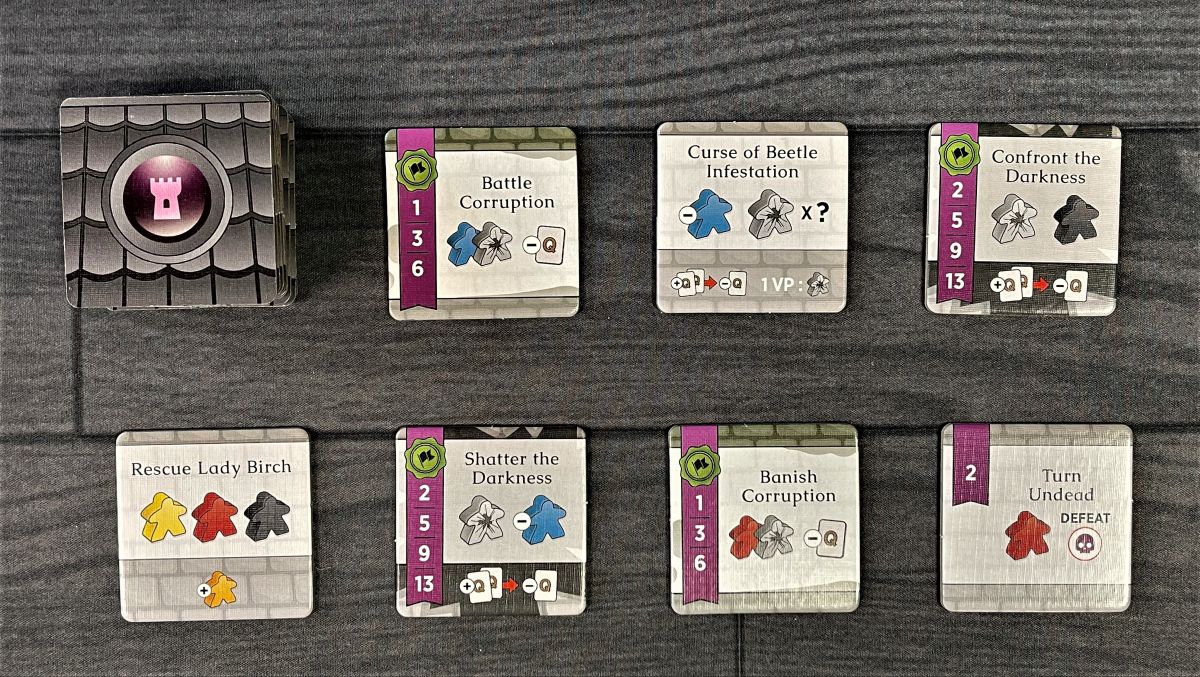
There are a number of monsters that you can fight throughout the game. They come in three different difficulty levels, as indicated by the colored circles on the right side of their cards.
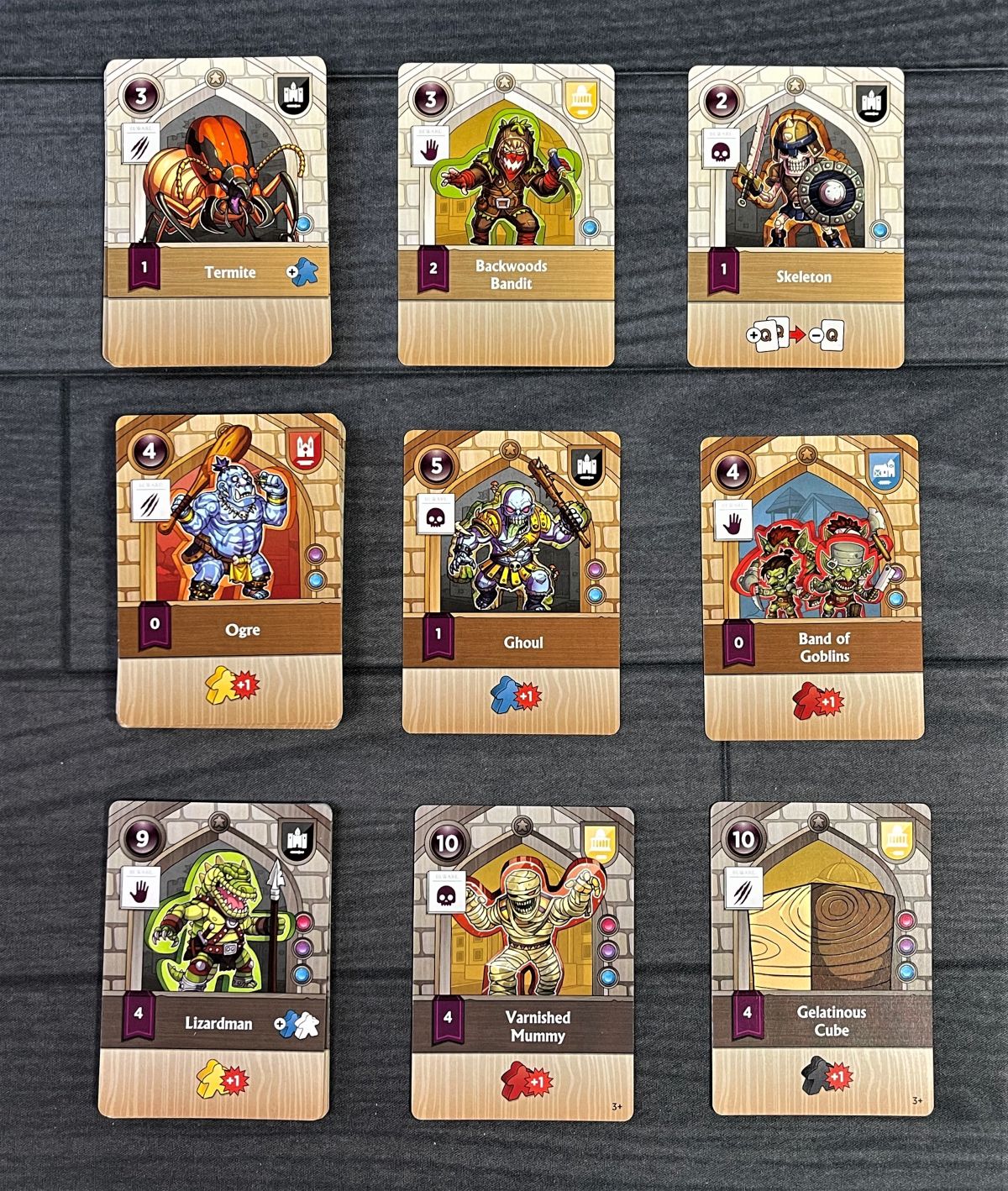
There are also Quests that you can complete in the game to gain Victory Points. Players start with two Quests, but there are ways to gain more, or even get rid of some of the ones that you have.

While my copy is a prototype, it’s hard to imagine that AEG will improve much on the final quality of the components. The cards all have a nice linen finish, the meeples have characterful screen prints, and the boards are all of good quality. Really, the only things in the box that were unexceptional were the bags to put your meeples in. And as I already pointed out, backers of the Kickstarter will be getting much better bags when they receive their pledges.
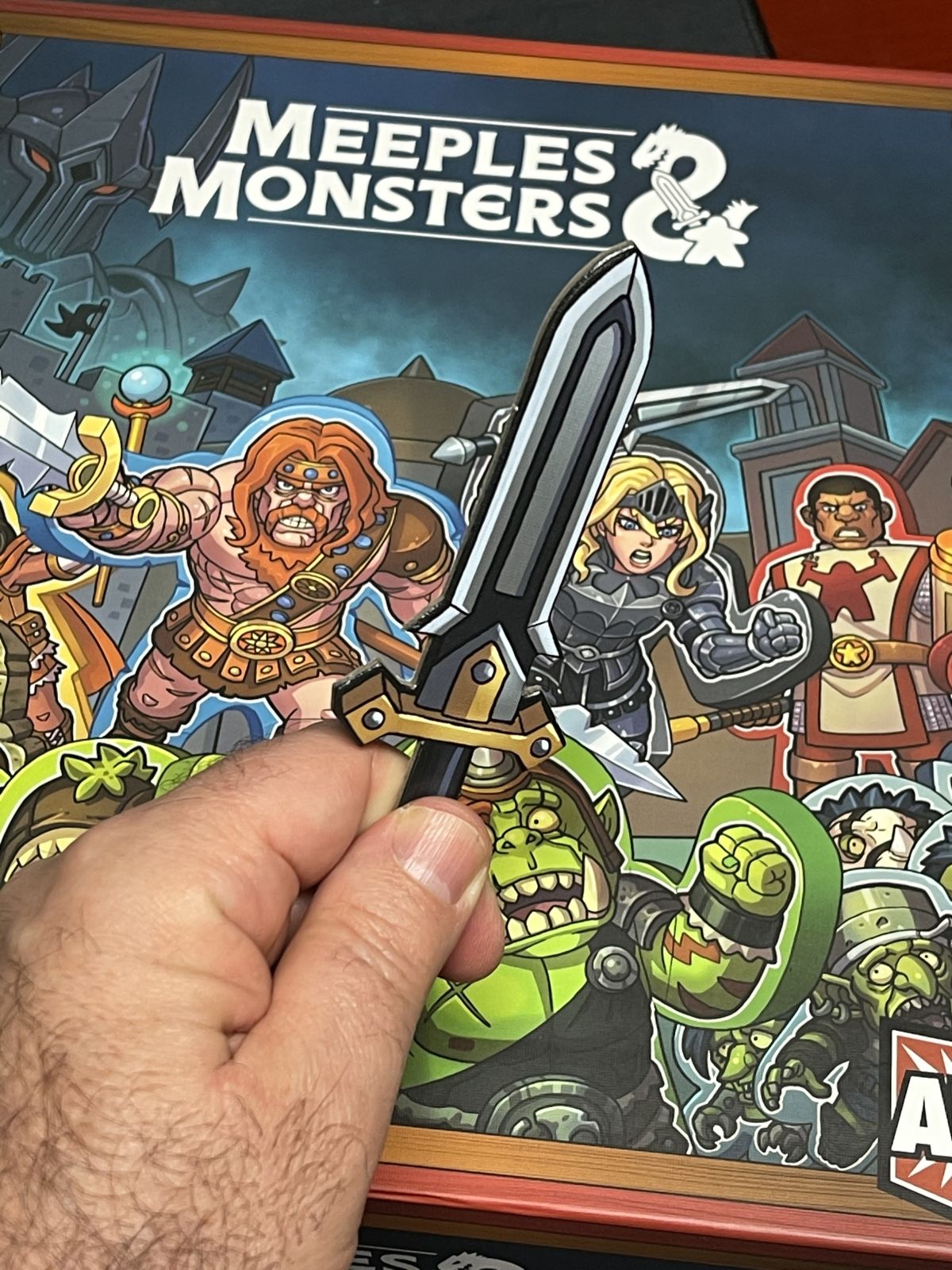
How to Play Meeples & Monsters
You can watch a tutorial for the gameplay here:
Or read a draft of the rulebook here.
The Goal
The goal of Meeples & Monsters is to build an effective bag of meeples, so that you can complete Quests, defeat monsters, and gain the most Victory Points by the end of the game.
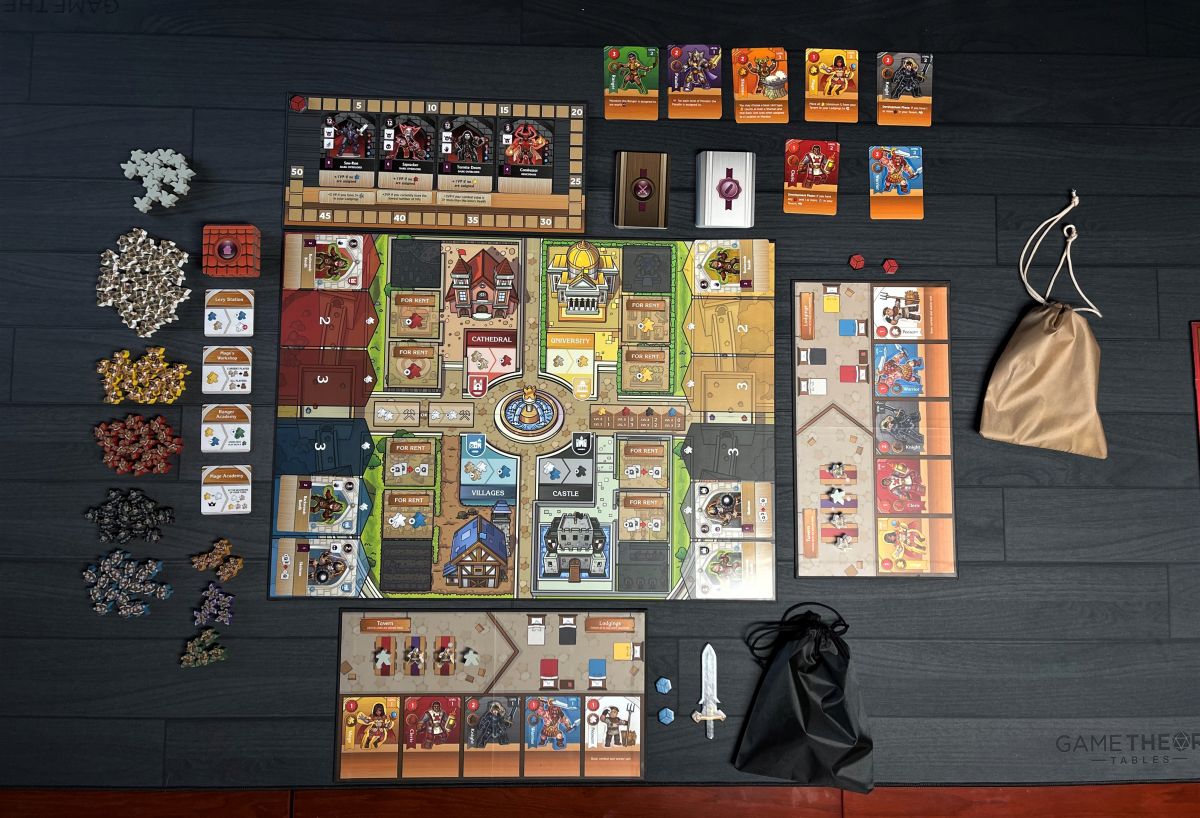
Setup
Place the game board in the center of the table. Place the final encounter board nearby, and add the Dark Council cards onto it, with the Henchman in the far right slot. Shuffle the Dark Council Ability tokens and place one under each member of the Dark Council. The Henchman has no ability token.

Each player takes a bag, player board, and player marker in the color of their choice. One of the player markers goes onto the “0” space on the Final Encounter board.
Sort the meeples by color and put them in piles near the game board.
Divide the monster cards into three different stacks, for the three different levels of monster. If playing with fewer than 3 players, remove any of the cards that show “3+” on them. Shuffle those stacks.

Create the monster deck following these steps:
- Shuffle one of the three “Dark Council Arrives” cards into the bottom four cards of the level 1 monsters.
- Shuffle one of the Dark Council Arrives cards into the bottom eight cards of the level 2 monsters.
- Shuffle the last Dark Council Arrives card into the bottom half of the level 3 monsters.
- Form all three stacks of cards into a deck in ascending order, with the level 1 monsters on top.
Draw the top 6 cards of the monster deck, and place each monster into the region on the game board matching the symbol on the top right part of the card. Place the monster deck near the game board.
Shuffle the location tiles and deal out four near the board. Place the stack of remaining tiles next to them.
Each player takes 7 white Peasant meeples and 3 grey Corruption meeples and places them into their bag. Shake the bag to shuffle them up, then draw a starting group of 4 meeples, placing them into the Tavern area on the player board.
If playing with The Four Towers mini-expansion, shuffle those tiles and create four face-down stacks of 5 tiles each. Place one stack in each of the Tower locations on the game board, and flip the top room tile of each stack face-up.
The player with the most Corruption meeples in their tavern receives the First Player marker and starts the game.
Gameplay
The game is divided into 3 phases: Development, Main, and Draw. Each player will go through all 3 phases before it is the next player’s turn.
Development Phase
During this optional phase, you may build new locations or level up your heroes. You start by assigning meeples from your Tavern to the spaces on the game board, and then resolve the actions.

To build a location, you either assign two white Peasant meeples and then you can build one location tile, or you assign one Peasant meeple, but you will then also draw one additional meeple from your supply and place them in the Lodgings on your player board in addition to building.
You would then choose any of the four face-up location tiles, and place it into any space on the game board that says “For Rent.” Immediately take any bonus shown on the “For Rent” space, and draw another location from the stack to replace the face-up one taken.
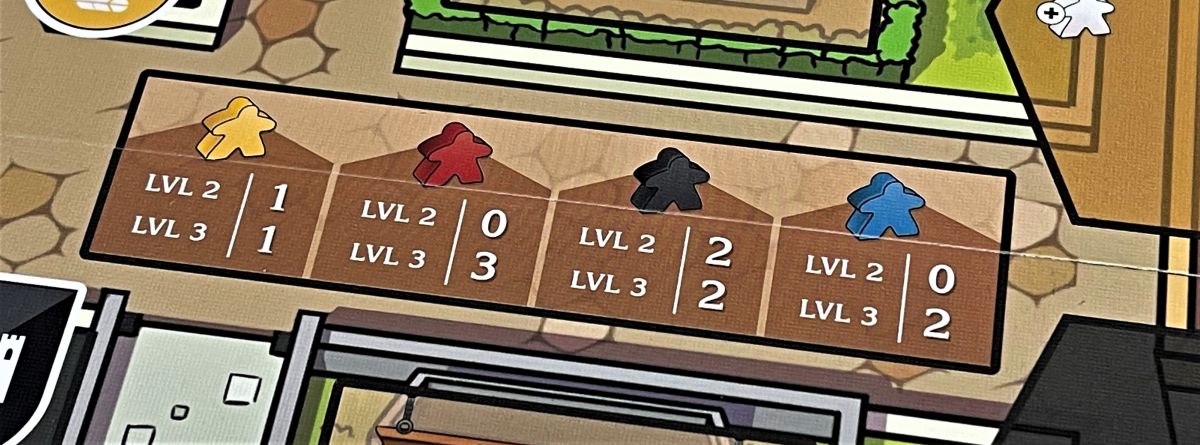
You can also level up one of your hero classes on your turn. Place a meeple of the matching color you want to level, and spend any victory points indicated on the location from the victory tracker. Take one of the cards matching that class and place it over the level 1 image on your player board if leveling from level 1 to level 2. If going from 2 to 3, simply flip over the hero card. Here are the level 2 and 3 cards for the basic classes:
After resolving the Development Phase assignments, collect any meeples placed during that phase and move them into the Lodgings on your player board. Those units are now exhausted.
Main Phase
During this phase, you will assign active Units (meeples in your tavern) to activate locations or fight monsters. As with the first phase, this phase is optional.
In addition to any locations that you may have built during a Development phase, there are also four permanent locations in the four different regions of the game board.
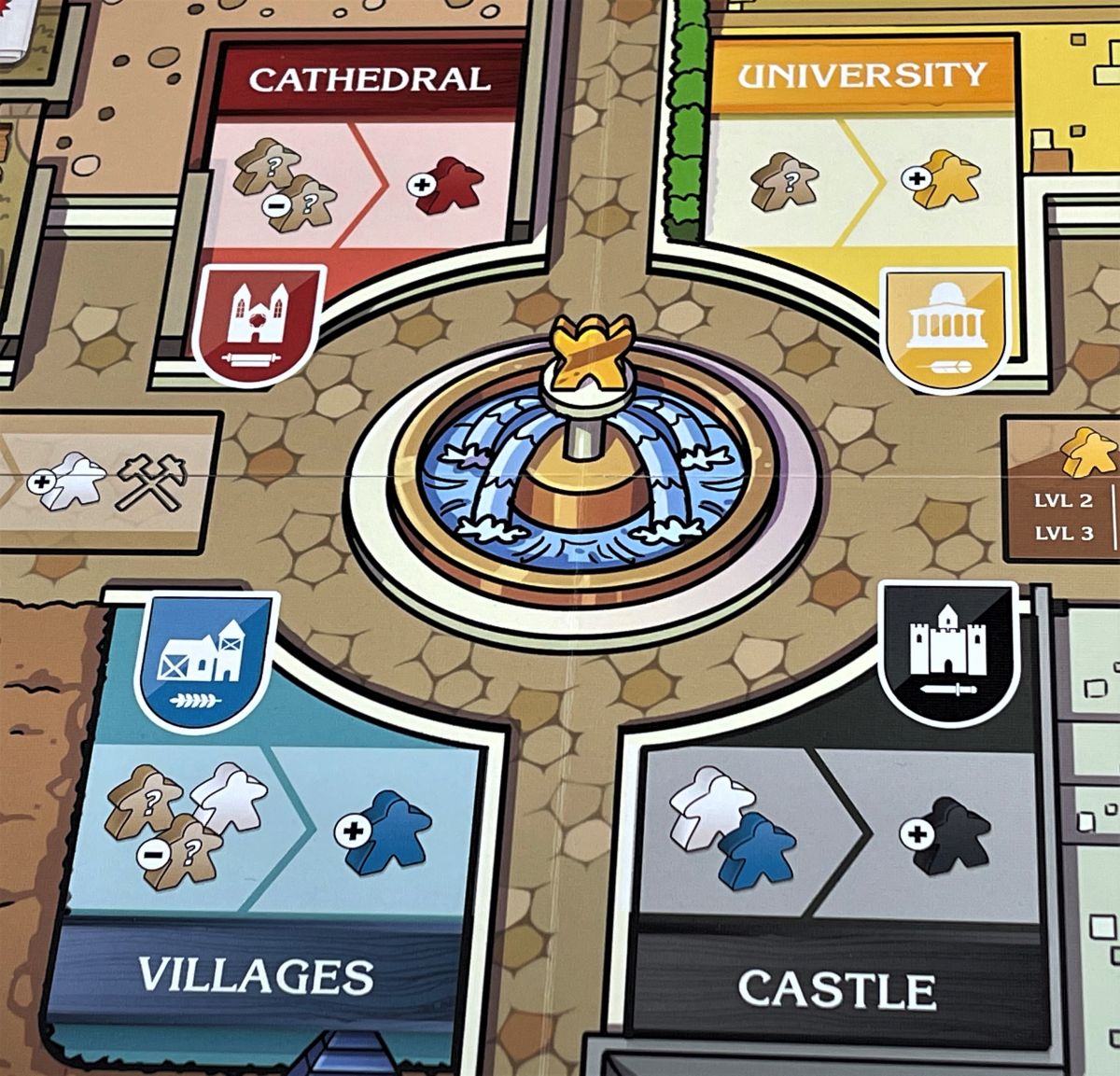
Each location has a different requirement to use, and provides a different effect. For example, the Castle location requires that you assign one Peasant and one Warrior. When you resolve the space, you will receive one Knight from the supply.
If you activate a location in one of the four quarters of the city that has two or more monsters, then you will have to draw either one or two Peasants and add them to your lodgings unless you have also assigned Units to defeat one or more of those monsters during your turn.
To combat a monster, you must assign enough meeples to equal or exceed the strength of the particular monster. Most of the meeples have a combat value of 1, but some, like the Knight, have a value of 2. Certain cards can also boost your combat value.

With the Giant Beaver pictured above, this is a level 3 monster that would require 9 combat strength to defeat. When you resolve the combat, you would receive 4 victory points on the victory point tracker, and a Peasant meeple. Whenever you defeat a monster, you take the card, and keep it in front of you. Some of the monsters, like the Giant Beaver, also provide you with ongoing effects. In this case, any of your Knights would now have +1 to their combat value in future combats.
After resolving locations and combats, any meeples assigned or gained during this turn are removed from the game board and placed in the Lodgings on your player board. Additionally, you would draw new Monster cards to replace any defeated on your turn, so that there are always six monsters on the board. Finally, any unused meeples in your Tavern are then moved to the Lodgings.
Draw Phase
Draw 4 new meeples from your bag and place them in your Tavern. If your bag is empty before you can draw all the needed meeples, then place all of the meeples from your Lodgings into the bag, shake them, and finish drawing to the full amount.
The first time that a “Dark Council Arrives” card is drawn, everyone adds a Corruption meeple to their bags. From that point on, you would then draw 5 meeples instead of 4 in this phase. When the next “Dark Council Arrives” cards is drawn, everyone again adds a Corruption meeple to their bags, and would then draw 6 meeples during the Draw phase.
Finally, activate any “Draw Phase” effects from Unit abilities or ongoing Quests. It is then the next player’s turn.
Quests
There are three types of Quests available: Triggered, Ongoing, and End of Game. Quests are worth Victory Points at the end of the game when completed, or cause players to lose Victory Points if they finish the game incomplete.
A Triggered Quest is completed as soon as the condition is met. Reveal the card, and immediately receive the reward shown on the card. Keep the card face-up in your play area.

An Ongoing Quest is completed as soon as its conditions are met. Place the card face-up in your play area, and receive any bonuses listed on your card. In addition, there is an ongoing effect that you may use once per turn if you meet the requirements. In the example above, the player would be able to draw an additional meeple during their draw phase, as they have 3 different meeples in their Tavern, one of which is a yellow Mage.
An End of Game Quest is only completed at the end of the game if you meet all the requirements.
Game End
After the 3rd Dark Council Arrives card is drawn, starting with the player with the First Player marker, each player will have two more turns before the game ends.
During these last 2 turns, players may now choose to assign their heroes to combat any of the Dark Council Overlords. The Overlords are never removed from the board, but each player may only fight each of the Overlords once (except the Henchman, who may be fought twice).
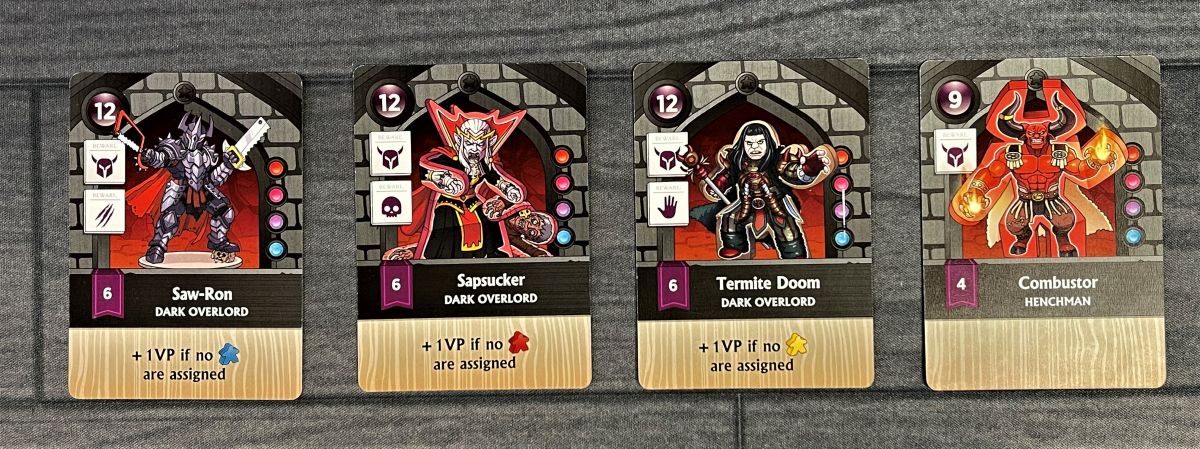
The Dark Council cards award any victory points shown, as well as any bonus points from the special effect at the bottom of the card and/or from the accompanying Dark Council Ability token.
After all players have taken their final 2 turns, the game ends. Each player will add Victory Points for any completed Quests, and take penalties for incomplete Quests. The player with the most Victory Points wins.
The Four Towers Mini-Expansion
The Rooms in the Four Towers mini-expansion (if used) function similarly to regular locations. There are two main differences:
- If you meet the requirements for a Tower Room, when you assign your meeples there you will actually take the Room and keep it in your play area, flipping over the next Room underneath in the stack.
- Some Tower Rooms function as sets: the more of them you claim, the more Victory Points you will gain at the end of the game.
Solo Mode
There will be a solo mode that ships with Meeples & Monsters. Unfortunately, the prototype I received did not include the rules or additional components required to play that mode.
Why You Should Play Meeples & Monsters
I love deck-building games. And at its heart, Meeples & Monsters is the same style of game, but instead of purchasing cards with different and better abilities and adding them to your deck, you’re purchasing and upgrading meeples, and adding them to your bag. Some of the best of those meeples are the Prestige classes, which are much harder to get as you must first build locations that will allow you to acquire them.

In the case of the location above, you would need to have previously acquired both a warrior and a cleric, and have both of them in your Tavern on your turn in order to place them at the location and acquire a Paladin. However, you would also lose that cleric (or, more thematically, he would level up and become the stronger Paladin). But as you can see, gaining a Paladin requires both planning and a little luck when drawing meeples out of your bag.
As I’d mentioned earlier, the rulebook recommends not playing with The Four Towers mini-expansion for your first game, and it’s sage advice. There are a LOT of choice to make during the game, and you can easily fall into analysis paralysis with all the choices available to you. The AEG developer who ran me through a demo said that he begins each game by looking at which Dark Council Ability Tokens are assigned to which Dark Council cards, and plans his overall strategy around fighting the bosses that will award him the most victory points at the end of the game.
This is good advice, but you also have to be ready to adjust to which locations are available during the game, which monsters are out, and which Quest cards are in your hand. There are many ways in Meeples & Monsters to add and subtract Quest cards throughout the game, but if you concentrate too much of your time on that, you may miss out on other, greater opportunities to rack up your Victory Points.
The first time I played, I pretty much ignored upgrading my heroes. This cost me later in my game, as it wasn’t easy for me to face-down the stronger level 2 and 3 monsters. Admittedly, as is typical of any time I play a game for the first time, I was more concerned with trying a little bit of everything to see how it worked. But without a concrete strategy to build my bag, I was floundering a bit by mid-game and trying to play catchup.
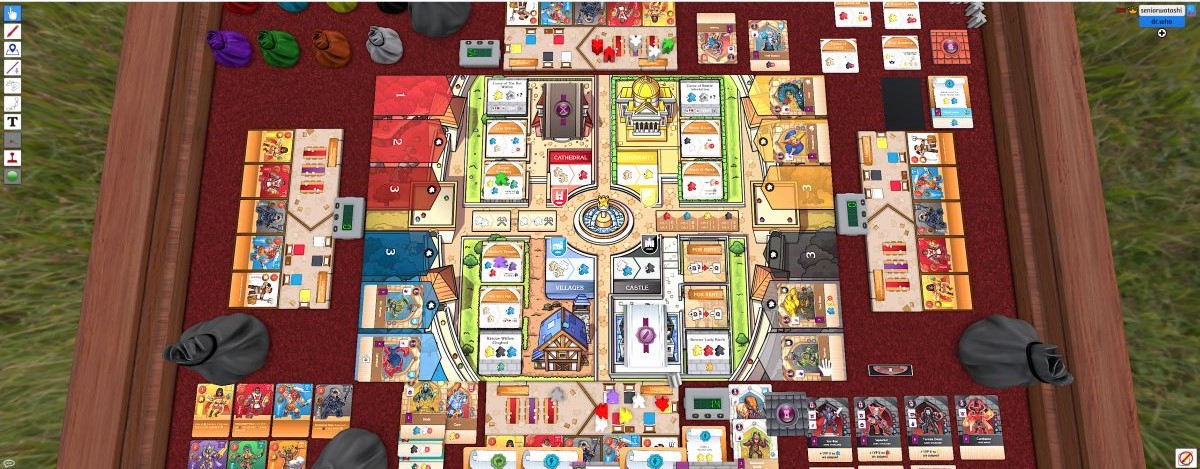
If you’re looking for a game with a lot of player interaction, this isn’t it. Unlike in most games where you place your workers at different locations, you always remove these meeples at the end of your turn. So while you’ll have plenty of choices to make playing Meeples & Monsters, you’re not racing your opponents to get to a prime spot first to block it off from anyone else. That being said, Tower Rooms, Monsters, and Prestige Class heroes are all limited resources. So if you want a particular one, you’d better grab it before someone else does.
And even though there isn’t a lot of interaction with other players, you don’t have a lot of downtime between players’ turns, either. Once you learn the order of play, things move along at a rapid clip. While you’re waiting to take your turn, you’ll be busy planning your next move, as you’ll already have drawn the meeples you’ll be assigning at the end of your previous turn.
AEG is a company that has been putting quality over quantity with their games, and Meeples & Monsters is no exception. From the characterful and colorful art design to the rock solid gameplay from Ole Steiness, this game is a lot of fun to play, and surprisingly deep strategy-wise. Expect to take a couple of games before you really get a good feel what all the icons mean without having to refer to the rulebook.
It also bears mentioning that Meeples & Monsters may not be available outside of Kickstarter, or if it does, it won’t have all the same content and will likely cost more. So if you don’t want to miss out, you’ll definitely want to back the campaign.
For more information or to make a pledge, visit the Meeples & Monsters Kickstarter page!
Click here to see all our tabletop game reviews.
![]() To subscribe to GeekDad’s tabletop gaming coverage, please copy this link and add it to your RSS reader.
To subscribe to GeekDad’s tabletop gaming coverage, please copy this link and add it to your RSS reader.
Disclosure: GeekDad received a copy of this game for review purposes.
